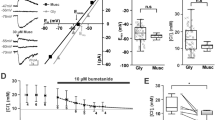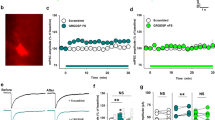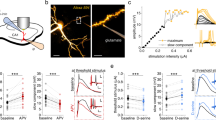Abstract
In the mammalian central nervous system, receptors for the excitatory amino-acid neurotransmitters are divided into three subtypes depending on their sensitivity to three specific agonists: kainate, quisqualate and N-methyl-D-aspartate (NMDA)1. The ionophores operated by NMDA are gated by Mg2+ in a voltage-dependent manner2–4 and allow passage of several cations, including Ca2+ (refs 5,6) which may be important in plastic alterations of neuronal excitability. Indeed, specific antagonists of NMDA receptors effectively block spatial learning7, long-term potentiation7,8 and some animal models of chronic epilepsy9,10. Despite their abundance on central neurons11, NMDA receptors, with a few noteworthy exceptions12,13, do not generally seem to be involved in low-frequency synaptic transmission14. Here we report for the first time that NMDA receptors of the dentate gyms, where they do not normally contribute to the generation of synaptic potentials7,15,16, become actively involved in synaptic transmission following long-lasting neuronal changes induced by daily electrical stimulation (kindling)17 of the amygdala or hippocampal commissures. In contrast to controls, the excitatory postsynaptic potentials (e.p.s.ps) of granule cells in hippocampal slices obtained from kindled animals displayed characteristics typical of an NMDA-receptor-mediated component. The involvement of NMDA receptors in synaptic transmission may underlie the long-lasting changes in neuronal function induced by kindling.
This is a preview of subscription content, access via your institution
Access options
Subscribe to this journal
Receive 51 print issues and online access
$199.00 per year
only $3.90 per issue
Buy this article
- Purchase on Springer Link
- Instant access to full article PDF
Prices may be subject to local taxes which are calculated during checkout
Similar content being viewed by others
References
Watkins, J. C. & Evans, R. H. A. Rev. Pharmac. Tox. 21, 165–204 (1981).
Adult, B., Evans, R. H., Francis, A. A., Oakes, D. J. & Watkins, J. C. J. Physiol., Lond. 307, 413–428 (1980).
Nowak, L., Bregestovski, P., Asher, P., Herbet, A. & Prochiantz, A. Nature 307, 462–465 (1984).
Mayer, M. L., Westbrook, G. L. & Guthrie, P. B. Nature 309, 261–263 (1984).
MacDermott, A. B., Mayer, M. L., Westbrook, G. L., Smith, S. J. & Barker, J. L. Nature 321, 519–522 (1986).
Lambert, J. D. C. & Heinemann, U. in Calcium Electrogenesis and Neuronal Functioning (eds Heinemann, V. et al.) 279–290 (Springer, Heidelberg, 1986).
Morris, R. G. M., Anderson, E., Lynch, G. S. & Baudry, M. Nature 319, 774–776 (1986).
Collingridge, G. L., Kehl, S. J. & McLennan, H. J. Physiol., Lond. 334, 33–46 (1983).
Croucher, M. J., Collins, J. F. & Meldrum, B. S. Science 216, 899–901 (1982).
Peterson, D. W., Collins, J. F. & Bradford, H. F. Brain Res. 311, 176–180 (1984).
Monaghan, D. T. & Cotman, C. W. J. Neurosci. 5, 2909–2919 (1985).
Thomson, A. M., West, D. C. & Lodge, D. Nature 313, 479–481 (1985).
Salt, T. E. Nature 322, 263–265 (1986).
Watkins, J. C. Trends pharmac. Sci. 5, 373–376 (1984).
Crunelli, V., Forda, S. & Kelly, J. S. J. Physiol., Lond. 341, 627–640 (1983).
Mody, I. & Heinemann, U. Neurosci. Lett. 69, 137–142 (1986).
Goddard, G. V. Nature 214, 1020–1021 (1967).
Bliss, T. V. P. & Lomo, T. J. Physiol., Lond. 232, 334–356 (1973).
Bliss, T. V. P. & Gardner-Medwin, A. R. J. Physiol., Lond. 232, 357–374 (1973).
Wadman, W. J., Heinemann, U., Konnerth, A. & Neuhaus, S. Expl Brain Res. 57, 404–407 (1985).
Miller, J. J. & Baimbridge, K. G. Brain Res. 278, 322–326 (1983).
Oliver, M. W. & Miller, J. J. Expl Brain Res. 57, 443–447 (1985).
Racine, R. J. Electroenceph. clin. Neurophysiol. 32, 281–294 (1972).
Mody, I., Lambert, J. D. C. & Heinemann, U. J. Neurophysiol. (in the press).
Stanton, P. K., Jones, R. S. G., Mody, I. & Heinemann, U. Epilepsy Res. 1, 53–62 (1987).
Crunelli, V. & Mayer, M. L. Brain Res. 311, 392–396 (1984).
Herron, C. E., Williamson, R. & Collingridge, G. L. Neurosci. Lett. 61, 255–260 (1985).
Slater, N. T., Stelzer, A. & Galvan, M. Neurosci. Lett. 60, 25–31 (1985).
Author information
Authors and Affiliations
Rights and permissions
About this article
Cite this article
Mody, I., Heinemann, U. NMDA receptors of dentate gyrus granule cells participate in synaptic transmission following kindling. Nature 326, 701–704 (1987). https://doi.org/10.1038/326701a0
Received:
Accepted:
Issue Date:
DOI: https://doi.org/10.1038/326701a0
This article is cited by
-
Inhibition of the NMDA Currents by Probenecid in Amygdaloid Kindling Epilepsy Model
Molecular Neurobiology (2024)
-
The 1980s: d-AP5, LTP and a Decade of NMDA Receptor Discoveries
Neurochemical Research (2019)
-
Epilepsy in the cancer patient
Cancer Chemotherapy and Pharmacology (2011)
-
Regional Changes in Gene Expression after Limbic Kindling
Cellular and Molecular Neurobiology (2011)
-
Sub region-specific modulation of synchronous neuronal burst firing after a kainic acid insult in organotypic hippocampal cultures
BMC Neuroscience (2008)
Comments
By submitting a comment you agree to abide by our Terms and Community Guidelines. If you find something abusive or that does not comply with our terms or guidelines please flag it as inappropriate.



